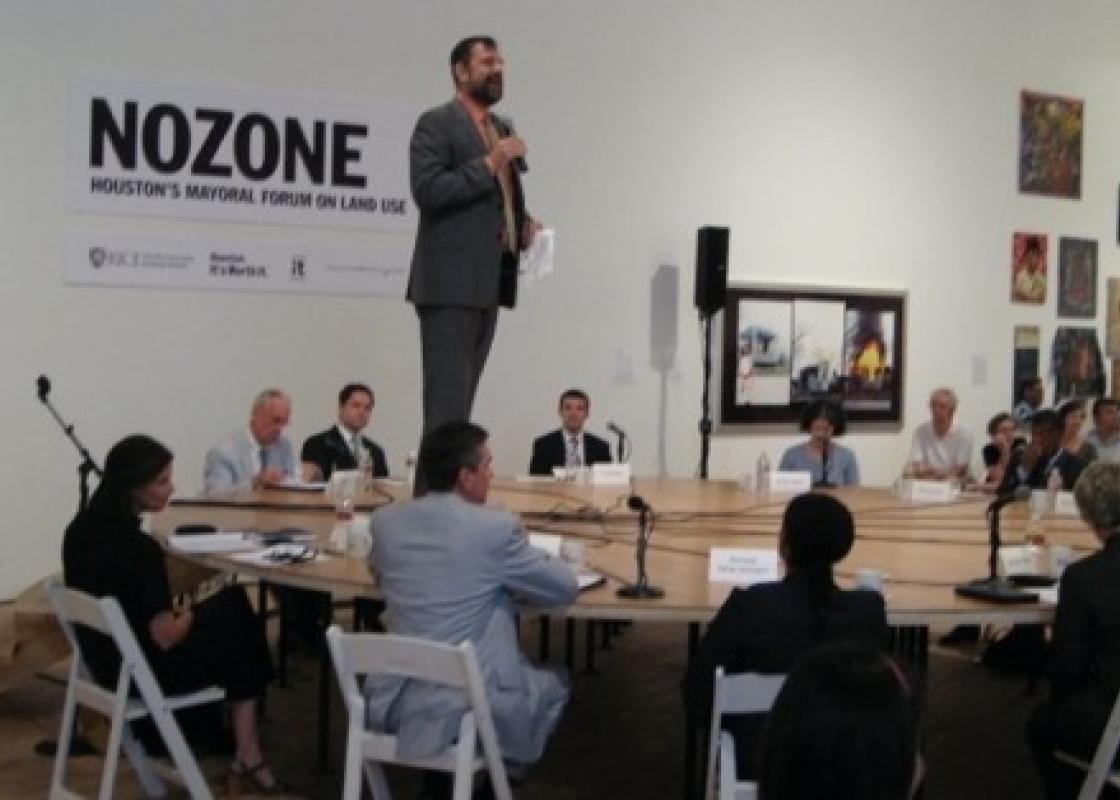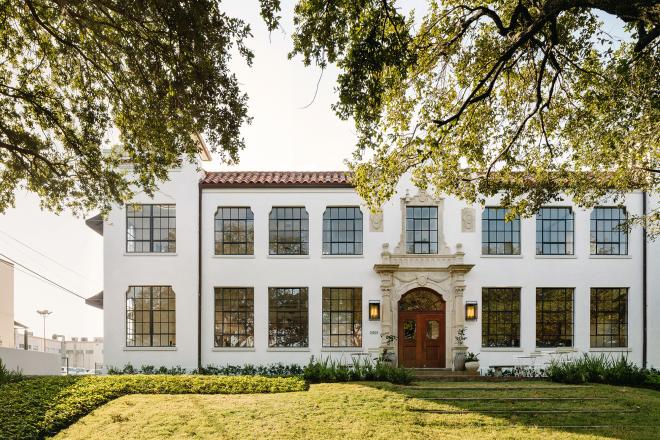On Thursday July 9, 2009, the Contemporary Arts Museum Houston held a mayoral forum moderated by Rice architecture professor Mary Ellen Carroll and attended by the following candiates: Peter Brown, TJ Huntley, Gene Locke, Roy Morales, and Annise Parker. If you missed it, here's your chance to find out what happened including links to responses, an audio recording, and embedded videos.
Christof Spieler wrote a response to the forum on Intermodality. Though he posted a complete audio recording (82 mb wave file), Spieler writes that "none of the answers were really all that interesting." Rather than dwell on the answers, he responds to the questions himself. (The video is at the bottom of this page.)
Mike Snyder, a Chronicle reporter, also wrote about the forum on the paper's Houston politics blog. He seemed underwhelmed by the responses from the candidates as well, describing the event as "a polite discussion that reflected more agreement than divisions." Snyder's assessment ignores Roy Morales who said at the outset, "My whole philosophy is reducing the size of government and reduce our taxes. I'm the only candidate committed to reducing taxes and size of government." In every answer, he reiterated this statement, which was at odds with the consensus of the remaining candidates. Perhaps it is easy for Snyder to forget Morales because of his low fundraising totals in comparison to Annise Parker, Peter Brown, and Gene Locke. Those other candidates all seemed to agree that better incentives, standards, and deed restrictions were needed to encourage smart growth and stabilize neighborhoods. (The Ashby Highrise lurked in almost every question and response whether directly mentioned or not.)
Surveying the websites beforehand, I thought Annise Parker would own the event. She has issued specific briefs on many of the questions raised. She had an unfortunate seat at the round table, though, that faced her away from the entire audience and seemed ill at ease with the format. She did highlight some specifics, like her advocacy for the protection of the 6th Ward, but she was often explaining the limits of the mayor's powers. Peter Brown, who is an architect, was in his element. The audience was full of designers and he surely recognized many of the faces. He quoted from Jane Jacobs, the architectural critique and author of Death and Life of Great American Cities. He talked about Transit Oriented Development (TOD). He committed to signing the US Mayors Climate Protection Agreement. Gene Locke, whose website does little more than tout his biography, came across as charismatic, full of ideas, and aware of the complexity of city government despite his lack of experience. He often bills himself as a "free-market kind of guy," but at one point he asked, "Why not offer tax abatement and incentives for bike racks and showers? Why not create a RFP to create an electric grid for plugging in cars in garages?" He also talked about rewriting Chapter 42.
Spieler is right, however, that the questions stole the show. They were far more elaborate and erudite than I have seen in other forums and debates. Some were bewildering and too long. Several answered themselves. It was if the event was less a forum than an assertion of Houston's coming of age, that the candidates were being informed of a community of people expecting a higher level of discourse, that voters want candidates who can speak clearly about land use and who are prepared to lead the city through its ongoing population boom into a more livable and sustainable future.
NoZoning Forum Questions
7:15 First Question: Land Use Policy
Question proposed by Hugh Rice Kelly, attorney
Respondents: Asmara Tekle-Johnson, Assistant Professor, Thurgood Marshall School of Law; Hugh Rice Kelly, attorney
A novel approach to zoning within defined boundaries for the otherwise ‘no zoned’ City of Houston, was proposed in House Bill 4648 (see below for the explanation) in this spring’s 2009 Texas legislative session. Please respond if you were able to participate and had to vote on such a bill, would you have voted YES or NO. In addition, please provide an explanation for your decision.
Sponsored by Representative Garnet Coleman, this bill would apply the area zoning concept with the zoning district governed by state law. The statute would define a process under which residents of area having no less than 90 percent single-family homes could petition the City to create a Residential Management District. This District would have zoning power as well as any other power defined in its charter. The main points and limitations in the bill would be the following...(click here to download the document with the full question
…
The justification for the creation of such districts is that deed restrictions legally cannot be created or reinstated to protect some single family residential areas in Houston, mostly in older neighborhoods developed before 1950:
• There are certain single-family areas of the city where deed restrictions lapsed so long ago that they cannot be revived. This is true for some of the neighborhoods in the Riverside area of Third Ward.
• There are certain single-family areas of the city in which there are numerous but scattered individual properties whose deed restrictions have long since lapsed, or which never were subject to deed restrictions. This is true for Boulevard Oaks, for example, but not Southampton, which adjoins the south side of Boulevard Oaks.
• Deed restrictions cannot protect these single-family residential areas from a development such as the Ashby High Rise.
• The strong and extensive deed restrictions used in postwar master planned communities cannot as a practical matter be imposed on existing neighborhoods. Most of these modern deed restrictions impose land use controls as strict or stricter than a zoning ordinance.)
7:30 Second Question: Transportation
Two part question proposed by the Citizens’ Transportation Coalition
Respondent: Robin Holzer, Chair, Citizens’ Transportation Coalition
The land area of the fourth largest city in the United States (594.13 square miles) is greater than some states. Mobility is multi-modal. Transportation and land use are increasingly acknowledged as major factors affecting neighborhood quality of life. Roadways are used by cars, buses, and bicycles. and sidewalks can provide access to pedestrians, wheelchairs, scooters, and transit users. Better planning will benefit Houston neighborhoods; however, within the City of Houston, transportation-related planning functions are divided between the Planning & Development department and the Public Works & Engineering department.
First, would you support a policy to make sure every transportation-infrastructure project within the City of Houston—regardless of the implementing agency or department—preserves or enhances the full spectrum of mobility uses, including auto, pedestrian, bicycle, and transit access and how would you encourage developers in their proposed projects to provide easy access to these systems? Secondly, should the City have a single department with responsibility for transportation planning? Please provide a YES or NO response. In addition, please provide an explanation for your decision.
7:45 Third Question: Education
Question proposed by Gerald Frug, the Louis D. Brandeis Professor of Law at Harvard Law School and author of the CITY BOUND, How States Stifle Urban Innovation and City Making: Building Communities without Building Walls
Respondent: Janet Kohlhase, Professor of Urban Economics, University of Houston
Unlike most major cities in the country, Houston has several different schools districts rather than one city-wide district. Do you think that this system segregates education within the city and, if so, would you pledge to do something about correcting the problem and what would that be? Please provide a YES or NO response. In addition, please provide an explanation for your decision.
8:00 Fourth Question: Growth and Incentives
Question proposed by Samuel Jacobson, undergraduate at the School of Architecture, Rice University
Respondents: Jenny Hyun, attorney; Reid Wilson, Chair, Urban Land Institute
Houston has grown with the proven formula of private investment following public investment in infrastructure. The City has been able to use its authority over Municipal Utility Districts within its extraterritorial jurisdiction to guide greenfield development on the city’s edge—ensuring a good business climate for developers , economic growth, and the continued expansion of the property-tax base. Another potentially similar form of control over infrastructure is the city’s control over mass transit and its investment in the light rail system. This has not been very effective at guiding development in the city’s urban core, where developers seem to be more responsive to tax-based programs (for example, Tax Increment Reinvestment Zones or TIRZs) than direct investment in infrastructure. Given the controversy over Buckhead Investment Partners’ proposal for a highrise at 1717 Bissonnet (the “Ashby Highrise”), might the city have been able to take a more proactive approach and incentivize the developers and the community to transfer the project to a site along the Main Street Corridor and Metro’s light rail line, in exchange for limiting the size of the proposed development on the Bissonet site. This type of planning would encourage innovative thinking and development for the future of the City of Houston. How might infrastructure be used to proactively shape or reshape Houston’s already existing urban fabric?
Fifth Question: The Future
Question proposed by members of the Sharpstown Civic Association
Respondents: Reid Wilson, Chair, Urban Land Institute; Jordan Fruge, SVP, Business Development, Standard
Renewable Energy
Mayor Bill White has had some of the highest approval ratings of any elected mayor and was recently named one of seven “eco-mayors” for his commitment to improving the sustainable practices in the city of Houston. By this time next year, the stimulus funds allocated for proposed and ‘shovel ready’ projects will be underway and one of you will be the new elected mayor of the city of Houston. The city has been referred to as many things, but in terms of industry, ‘energy capital of the world’ is the historical moniker that the city rightfully cultivated and owns. Today, it would be hard-pressed to retain this classification without qualification.
This spring the same state legislature session that killed the ‘zoning’ bill for Houston also voted against a bill for solar rebates, as well as a bill that would make it harder for homeowner’s associations to ban solar panels. The city itself is making every effort to incorporate these technologies into its own buildings, practices and policies. This is evidenced by the creation of the Public Works & Engineering Green Building Department; the creation of the park and application of solar arrays at Discovery Green; and the proposed weatherization and retrofit programs for aging subdivisions that will begin later this summer. It seems nearly impossible, however for private businesses and homeowners to afford these renewable technologies.
If renewable energy is not accessible or affordable and it only exists as a municipal showcase; if the utility companies do not facilitate the buy and tie back into the grid; what incentives do the solar manufacturers, energy companies and other renewable energy technologies have to set up manufacturing, marketing and servicing facilities as well as job training programs in the Houston area? What if a location like the Sharpstown Mall (that suffers from an ill-gotten perception problem that bleeds into an affordable, stable, and diverse, middle-class community) was to be redeveloped into an area for the incubation and application of these renewable technologies? If elected mayor, what would you propose as an expansive proposition for the future of the city of Houston that would eliminate the necessity of this qualification to truly make it the ‘energy capital of the world’. (Please provide in your response a specific program or incentive for homeowners, businesses or industry and how this would be done, where it would be done, or idea for the response.)










